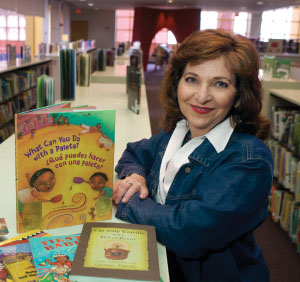Syllabus
Cultural Mirrors
If there ever were a match made in heaven between class and instructor, it’s Course 5193 and Carmen Tafolla.
The course is Multicultural Literature for Children, in the College of Education and Human Development’s Bilingual-Bicultural Studies program, and the instructor is one of the most acclaimed authors in the field.
This spring term, 12 graduate students and Tafolla together explored and analyzed culture and diversity in children’s books.
Tafolla, who grew up on the West Side of San Antonio in one of the city’s poorest neighborhoods, is an internationally acclaimed writer and award-winning author of children’s literature. To date, she has published five books of poetry, eight children’s picture books, seven television screenplays, two nonfiction volumes and a collection of short stories.
The course is described in the catalogue as “the study of representative children’s literature for, and about, the many culture groups in the Americas, with emphasis on Latinos and Latinas.” As it turns out, the course is a perfect platform from which Tafolla can share her knowledge with graduate students who are either already classroom teachers or are working toward that goal.
Tafolla loves teaching. “The best way to learn something is to teach it. In the process of explaining it, you discover dimensions you didn’t know existed,” said Tafolla, who was recently hired as a senior lecturer for the college. “This class is a collaborative learning experience. We learn from each other, challenge and question each other—we push the edge.”
Omar Mendoza, a graduate student of Tafolla’s, said he enjoys her class. “She teaches us ways to look at books differently and challenges you to find yourself in the books that you read.”
Tafolla knows that literacy rates today are at a crisis level, particularly for minorities. “Children do not see themselves reflected in the literature. Many have different experiences than the ones that the traditional classroom has been set up to support. And, the less you see yourself, the less you want to be involved, the less school even makes sense.”
One of the goals of the curriculum is to teach how to analyze books written for children and young adults. “This class looks at what is right with a book and also what is wrong,” said Tafolla. “We learn to be very, very aware of all the implications a book, or a whole era of books, can transmit to young people.”
In her class, one week the theme could be gender messages. Another week the focus might be diversity.
“We learn that diversity is always a positive—in nature, in science, in human tesoros,” she said. “Diversity is more than the differences we have in ethnicity and language. Many students today are from nonstandard families, and to help a child see herself in the story, we must show respect for all individuals and all kinds of households, and this respect should have its cultural support structure in the books and media we use.”
According to graduate student Dora Moreno, “Professor Tafolla makes you think about what you are reading. She challenges us to go beyond the words and figure out what is also going on in the background. And then, to figure out what the message is and ask the question: Is this an appropriate message?”
What advice would Tafolla give parents buying books for their own children?
“Parents should know that reading offers their child a window to the world, so they need to find literature that has ‘windows’—by that I mean finding things that open up brand new experiences for their child,” Tafolla said.
Just as important, said Tafolla, are stories that have mirrors. “If a child can find his own experiences reflected in the story, then that reflection will affirm and lead to a pride in the ‘specialness of being me’ and will connect them to the world of books.”
And last but not least is passion, she said. “Find stories that your child will love to read, and if possible, stories that you yourself enjoy reading, because your children will pick up on your enthusiasm or lack of it. I read three stories a night to my 5-year-old, and sometimes it’s the same book, read three times over because she loves it so much. I indulge that passion for a story, because then, emotionally, that story belongs to her.”
—Marianne McBride Lewis

